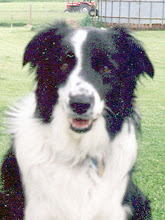When I pick up Dewey Kitty, I bury my nose in the scruff of his neck.
Today, he smelled of the sun-soaked tomato plants he'd napped under.
This is a change from the previous few days, when he smelled of alfalfa hay.
This summer, as Dewey has taken to spending his days outdoors, the sniff of the neck has become a ritual. It tells me where he's been, and is always some delightful summer smell.
I don't put my nose near the Border collies, though.
For they are dogs.
They like to perfume their scruffs with sheep poo, raccoon droppings and decaying rabbits and birds.
Meanwhile on the farm: In early summer, it never seemed to stop raining. However, in the past few weeks, the rains subsided, and I found vegetables in the garden, and caught up with mowing.
This week, I also said good-bye to Trick, the best barn cat ever. This cat saw the other farm critters as his playthings. You could count on him to do things, like lying in the arena when you were trying to lunge a horse; or pouncing on a Border collie who was running out to gather sheep, or wrapping his legs around lamb necks and licking milk off their mouths.
Well into his teens, he'd gotten arthritic in the past few years. I'd set up steps to his feeding table and left some stall doors open so he could move about without having to leap four feet or encounter dogs. Last month, he developed a tumor near his eye. But the vet and I agreed he wasn't ready to check out just yet. His weight was good, he was eating and still enjoying life.
Earlier this week, he ate breakfast as usual and then took a nap on his hay bale. He never woke up. And, I thought, how lucky is he? He lived a life, full of humor and fun, and had a quick death.
Here's a photo of him a few years back. Jack loved to stare at kitties. Trick said, "Whatever."

































